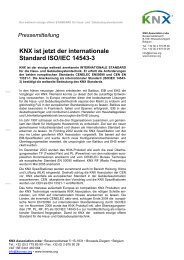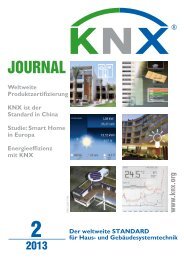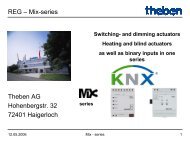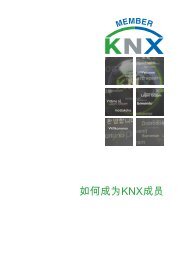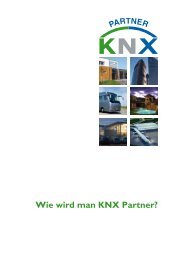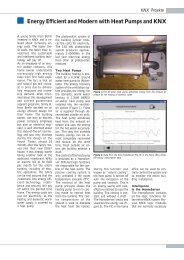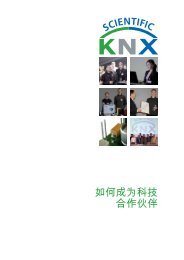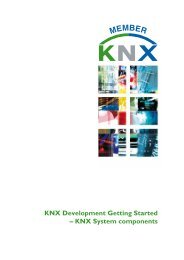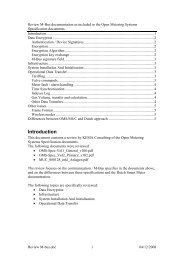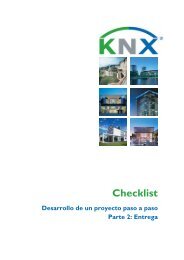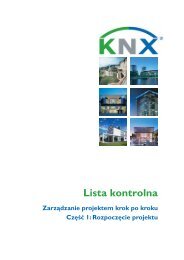Journal - KNX
Journal - KNX
Journal - KNX
Create successful ePaper yourself
Turn your PDF publications into a flip-book with our unique Google optimized e-Paper software.
EIB SOFTWARE<br />
Announcing the EIB Tool<br />
Environment Framework<br />
PC Programmers,<br />
watch out:<br />
Predators!<br />
EIB Tool Environment<br />
Framework im Kommen<br />
PC-Programmierer<br />
aufgepaßt:<br />
Raubvögel!<br />
EIB Tool Environment<br />
Framework est annoncé<br />
Programmeurs<br />
PC, voici les<br />
rapaces !<br />
Marc Gossens,<br />
EIBA System Manager<br />
After several years of successful<br />
distribution and with nearly<br />
6.000 licences of our EIB Tool<br />
Software (ETS) sold, EIBA has<br />
become a household name as the<br />
provider of the manufacturer-independent<br />
Software for EIB-Project-Engineering<br />
and Design.<br />
(See article on ETS 2 V 1.1 in this<br />
issue.) Via the EIB Tool Environment<br />
(ETE), the proven interfaces<br />
which ETS uses itself will now also<br />
be opened up for 3rd party use<br />
on a commercial basis.<br />
Currently available in a 16-bit<br />
version, these libraries are gradually<br />
being expanded into a richer<br />
set of 32-bit Application Programmer’s<br />
Interfaces (API) of Windows<br />
95. This endeavour will be<br />
completed by the end of next<br />
year. By that time, ETE will have<br />
developed into an encompassing<br />
framework for EIB programming<br />
on PC’s.<br />
For those of us who are familiar<br />
with the notion of Foundation<br />
Classes, the “framework” concept<br />
probably holds no secrets.<br />
Basically, a framework presents<br />
a set of standard software building<br />
blocks (or “components”) for<br />
a particular application domain.<br />
ETE of course deals with the familiar<br />
software infrastructure of<br />
the EIB system: mainly access to<br />
the EIB network, and to the ETS<br />
product and project databases.<br />
Still, with such features as the<br />
Product Snap-in interface for<br />
dedicated product support in<br />
ETS, ETE goes beyond the busand<br />
data-access libraries distributed<br />
so far.<br />
We will of course give you<br />
more details in this column, as<br />
this concept continues to unfold.<br />
For now, let us focus on the “Falcon“<br />
project.<br />
Nach mehreren Jahren erfolgreicher<br />
Verteilung der EIB<br />
Tool Software (ETS) und mit fast<br />
6000 ETS-Lizenzen wurde die<br />
EIBA zum Synonym des Lieferanten<br />
herstellerunabhängiger Software<br />
für EIB-Projekt-Engineering<br />
und -Design (siehe auch Beitrag<br />
zu ETS 2 V1.1 in dieser Ausgabe).<br />
Mit Hilfe des EIB Tool Environment<br />
(ETE) werden die bewährten,<br />
von der ETS genutzten<br />
Schnittstellen nun auch für die<br />
kommerzielle Nutzung durch Dritte<br />
freigegeben.<br />
Noch sind diese Bibliotheken<br />
nur in einer 16-Bit-Version verfügbar,<br />
aber sie sollen schrittweise<br />
auf die leistungsstärkere 32-Bit-<br />
API (Application Programmers Interface)<br />
von Windows 95 erweitert<br />
werden. Diese Umstellung<br />
wird im Laufe des nächsten Jahres<br />
abgeschlossen sein, und von<br />
diesem Zeitpunkt an wird ETE<br />
den entscheidenden Rahmen<br />
(Framework) für die EIB-Programmierung<br />
auf dem PC bilden.<br />
Für diejenigen, die mit dem<br />
Begriff „Foundation Classes“ vertraut<br />
sind, birgt das Konzept des<br />
„Framework“ wahrscheinlich kein<br />
Geheimnis. Bei einem Framework<br />
handelt es sich um einen<br />
Satz von Standard-Softwarebausteinen<br />
für einen bestimmten<br />
Anwendungsbereich. ETE bietet<br />
selbstverständlich die bekannte<br />
Software-Infrastruktur des EIB-<br />
Systems, vor allem den Zugang<br />
zum EIB-Netzwerk und zu den<br />
ETS-Produkt- und Projektdatenbanken.<br />
Mit Merkmalen wie der<br />
„Product Snap-In“-Schnittstelle<br />
für dedizierte Produktunterstützung<br />
in ETS geht ETE allerdings<br />
über die bisher angebotenen Busund<br />
Datenzugangsbibliotheken hinaus.<br />
Le succès rencontré depuis plusieurs<br />
années par notre logiciel<br />
EIB Tool et près de 6.000 licences<br />
ETS ont fait la réputation<br />
de l’EIBA comme le fournisseur<br />
du logiciel non propriétaire pour<br />
l’étude et la conception de projets<br />
EIB (voir l’article sur ETS2 V.<br />
1.1 dans ce numéro). A l’aide<br />
d’EIB Tool Environment (ETE), les<br />
interfaces éprouvées utilisées par<br />
ETS lui-même peuvent désormais<br />
l’être aussi par des tiers à des<br />
fins commerciales.<br />
Actuellement disponibles en<br />
version 16 bits, ces bibliothèques<br />
seront progressivement étendues<br />
en API (Application Programmer’s<br />
Interfaces) 32 bits<br />
plus performantes sous Windows<br />
95. Les travaux se poursuivront<br />
en 1997 et devraient s’achever<br />
en 1998. ETE sera alors devenu<br />
un cadre complet pour la programmation<br />
d’EIB sur PC.<br />
Le concept de « cadre » n’a<br />
sans doute pas de secrets pour<br />
ceux d’entre nous qui sont familiarisés<br />
avec la notion de « Foundation<br />
Classes ». Le cadre se définit<br />
comme un ensemble de modules<br />
logiciels standard (ou<br />
«composants») pour un domaine<br />
d’application particulier. Le cadre<br />
EIB Tool Environment, ETE, présente<br />
bien entendu l’infrastructure<br />
logicielle connue du système<br />
EIB : en premier lieu, l’accès au<br />
réseau EIB et aux bases de données<br />
produits et projets ETS.<br />
Avec des caractéristiques telles<br />
que l’interface Product Snap-in<br />
pour le support dédié des produits<br />
dans ETS, ETE dépasse<br />
toutefois le stade des bibliothèques<br />
d’accès au bus et aux données<br />
proposées jusqu’ici.<br />
Nous reviendrons bien entendu<br />
plus en détail sur ce thème à<br />
6 EIB-<strong>Journal</strong> 2/97




